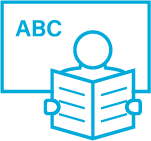


This study examines the contribution of early phonological processing (PP) and language skills on later phonological awareness (PA) and morphological awareness (MA), as well as the links between PA, MA, and reading. Children with poor early PP are more at risk of developing deficits in MA and PA than children with poor language. There is a direct link between PA and reading accuracy and between MA and reading comprehension that cannot be accounted for by strategy use at the word level.
Authors: Anna J. Cunningham & Julia M. Carroll
Source: Cunningham, A.J. & Carroll, J.M. (2013). Early predictors of phonological and morphological awareness and the link with reading: Evidence from children with different patterns of early deficit. Applied Psycholinguistics, 1–23. DOI: 10.1017/S0142716413000295
This study examines the contribution of early phonological processing (PP) and language skills on later phonological awareness (PA) and morphological awareness (MA), as well as the links between PA, MA, and reading. Children aged 4–6 years with poor PP at the start of school demonstrated weaker PA and MA after 3 years regardless of their language skills. Children with poor early PP are more at risk of developing deficits in MA and PA than children with poor language. There is a direct link between PA and reading accuracy and between MA and reading comprehension that cannot be accounted for by strategy use at the word level.
Early predictors of PA
Early predictors of MA
Links between PA, MA, and reading

Study
The present study follows up children initially recruited for a previous study comparing children at risk of reading difficulty with no-risk controls.
Research questions:
Method
Four subgroups were identified from 198 children initially tested during kindergarten or 1st grade when they were 4–6 years old. In total, 82 children were at risk of reading difficulties, and 116 children had no known risk factors. The final sample tested at Time 2 included 18 with double deficits, 15 with a single PP deficit, 17 with a single language deficit, and 114 with no deficit, from which 24 were placed in the matched no deficit group. Thus, the final sample comprised 74 children for the dynamic tasks.

Findings

Conclusions and implications
The results clearly demonstrated that the two groups of children with poor PP were consistently at risk of difficulties in both phonological and morphological areas. These findings suggest that children with poor language but good phonology at the start of school have relatively good outcomes. As children learn a wider variety of complex words, good PP skill may enable them to detect and process morphological regularities and affixes. Both phonological and morphological strategy use for nonword reading and spelling were predicted by PA but not MA. PA and phonological and morphological reading made a unique contribution to the prediction of reading accuracy. The results do support the hypothesis that PA has a direct effect on reading accuracy beyond its effect on sounding out unknown words. MA had a direct effect on reading comprehension after the effect of PA and nonword decoding had been partialed out. Based on the results of the present study, teachers may be able to select a clear group for additional support. It may also be beneficial for teachers to include more specific teaching of morphemes such that children learn to link morphology to the reading and spelling of new words.